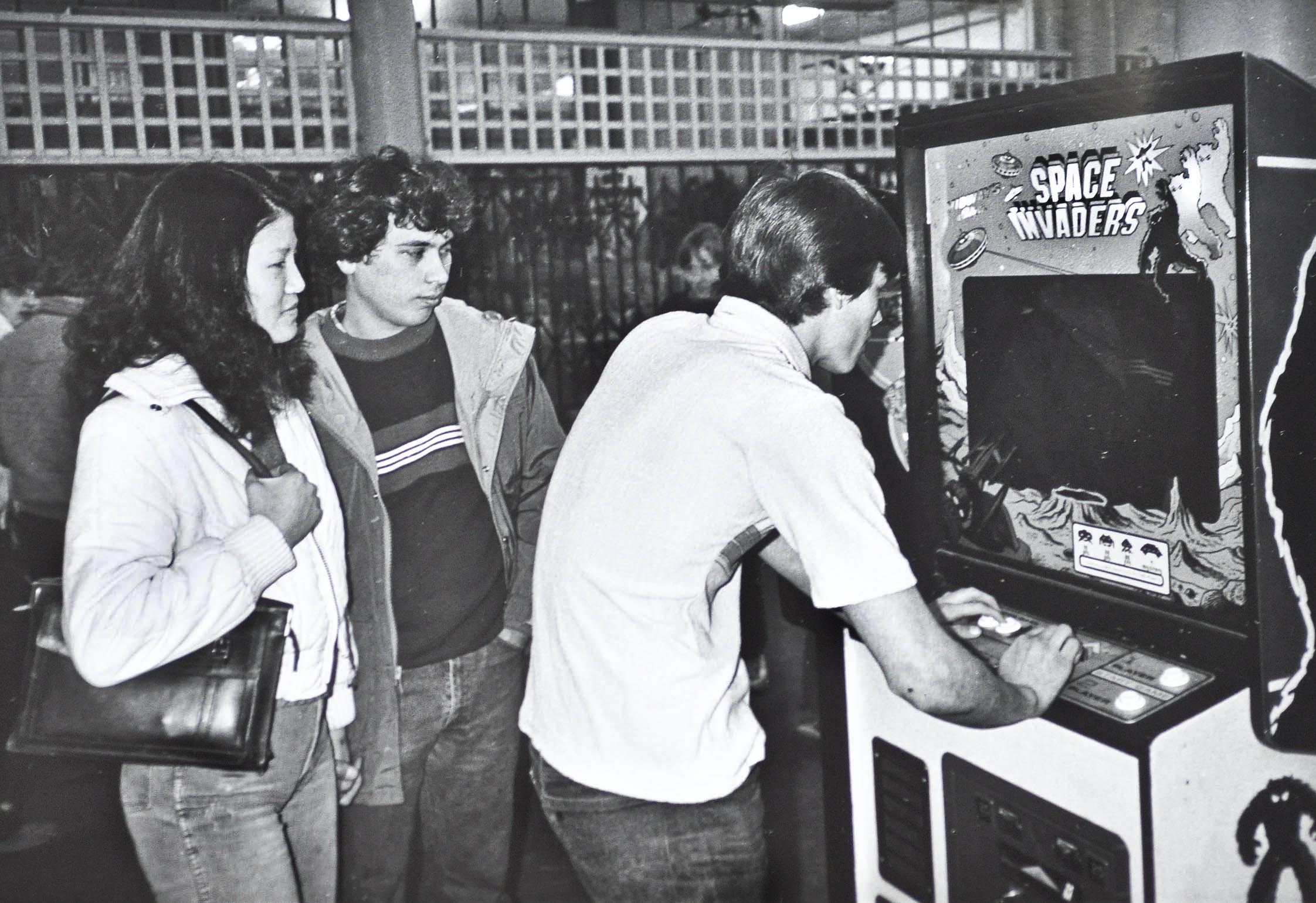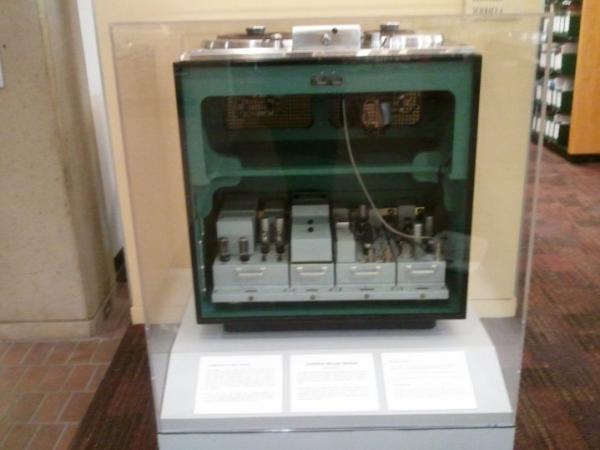Henry Lowood's blog
Stanford acquires archives of "Bay Area Video Arcades: Photographs by Ira Nowinski, 1981-1982."
2 August, 2012 - 15:19 — Henry LowoodThe Stanford University Libraries have acquired the photographic archives of "Bay Area Video Arcades: Photographs by Ira Nowinski," 1981-1982." The collection consists of approximately 650 35mm images, with contact sheets, as well as prints and digitized images for approximately 50 selected images.
Ira Nowinski is an acclaimed documentary photographer who has created extraordinary photo essays in a variety of areas of recent history, including North Beach in San Francisco, the evacuation of elderly citizens in San Francisco's SOMA district, aspects of Southeast Asian, Jewish, and Native American culture, and an important photographic study of Holocaust Memorials.

Ampex Model 200a installed in Green Library, Information Center
11 April, 2012 - 15:39 — Henry LowoodThis photo was taken just after the installation of the restored (to working condition) Ampex Model 200a in the Stanford Library's Information Center, in Green Library. It stands alongside the VRX1000. These two machines are the highlights of the hardware portion of our Ampex historical collection, showing off key artifacts from the early history of audio and video recording, respectively. The gentleman standing next to the machine is Larry Miller, a former Ampex engineer who did a marvelous job of restoring the machine to near-pristine condition. Interestingly, Larry's father ran an electronics shop in the 1940s and probably produced a number of prototype components for this very piece of equipment.
 Ampex Model 200a, Green Library, Information Center
Ampex Model 200a, Green Library, Information Center
Project Xanadu: Loss and Recovery
29 February, 2012 - 23:33 — Henry Lowood The text below is from "Project Xanadu: Loss and Recovery," a side-bar I wrote for the AIMS (An Inter-Institutional Model for Stewardship) Project Final Report on the building of framework for archival processing of born-digital materials. The report was issued in Jan. 2012. You can read about the project and get the final report here.
“What we're actually building at this point is only a part of Ted's original conception, though it's designed to be the first stepping stone to the whole thing.”
– Chris Hibbert, post to comp.multimedia newsgroup, 30 March 1992 (from file on XOR hard drive).
Ted Nelson’s Project Xanadu provided the original vision of hypertext as a system for document management, publication, linking and citation. Begun in 1960, the project to build Xanadu continued well into the 1990s. From 1989 to 1992, Autodesk funded Nelson’s Xanadu Operating Company (XOC) to complete software development. However, when a new group of programmers primarily from Xerox’s Palo Alto Research Center (PARC) joined the group in 1991, they abandoned the earlier version of Xanadu written largely by Roger Gregory and began a new version rewritten from scratch in PARC’s new programming language, Smalltalk. This forking of the project eventually led to the collapse of the Autodesk-funded effort. Keith Henson, an XOC investor, encouraged the Palo Alto-startup, Memex to pick up the project In 1994. Memex licensed Xanadu from XOC and brought the Xanada project to its office space on California Avenue. Before long, however, the arrangement collapsed. The team disintegrated, with Nelson and Gregory regaining control of Xanada, which would finally be released as the open-source Udanax system in 1999.
Journal of Visual Culture - special issue on machinima is out now
21 April, 2011 - 14:57 — Henry Lowood The April 2011 special issue of Journal of Visual Culture devoted to machinima is out now. Published by Sage Press, it was co-edited by Susan Rojo, Matteo Bittanti (former SHL), and me. So pretty much a HTGG-organized effort. You can read the issue here.
Digital Game Canon Re-Boot at PAX-East
12 March, 2011 - 16:56 — Henry LowoodAn excerpt from the Joystiq blog about the re-boot of the Digital Game Canon at a PAX-East Panel on Sunday, 13 March 2011: ""Ten Games You Need to Play: The Digital Game Canon" borrows its name from the 2007 GDC session of the same name, in which an incredible group of panelists (including this writer) deigned to select ten video games that deserved to be preserved. We're revisiting that effort, and reconsidering it with a stellar group of panelists."
Read more here:
http://i.joystiq.com/2011/03/12/pax-east-todo-the-digital-game-canon-a-panel-about-video-game/
Kevin Kelly at Stanford
11 January, 2011 - 21:44 — Henry LowoodKevin Kelly will be speaking on the Stanford University campus on Weds., Jan 19th, 6pm. His topic will be "What Technology Wants: Very Long-Term Trends in Technology." This will be a great opportunity to listen to the founding editor of Wired and prolific author of books such as Out of Control: The New Biology of Machines, Social Systems and the Economic World (Addison Wesley 1994, Perseus Books, 1995) and What Technology Wants (Viking, 2010).
See the attached poster for the location and please spread the word.
 Kevin Kelly at Stanford
Kevin Kelly at Stanford
Preserving Virtual Worlds is a Digital Preservation Award nominee
21 September, 2010 - 13:37 — Henry LowoodThe Digital Preservation Coalition (DPC) has officially announced the projects which have made the short list for the DPC awards. The nominees were announced at the iPres 2010 conference earlier today.
I am pleased to pass on the news that Preserving Virtual Worlds, our project with the Univ. of Illinois, Univ. of Maryland, and Rochester Inst. of Technology has been put on the short list for the international Digital Preservation Award. This award is presented in London as part of the Institute of Conservation ‘s (ICon) Conservation Awards.
The official news release is at http://www.dpconline.org/newsroom/latest-news/638-2010-digital-preservation-award-shortlists-press-release.
Speaking of PVW, we have just completed the final project report for the first two-year project funded by Library of Congress. You can find the report here:
https://www.ideals.illinois.edu/handle/2142/17097
Elijah Meeks interviews Tarn Adams
13 May, 2010 - 09:43 — Henry LowoodElijah Meeks, the digital humanities specialist in Stanford Academic Computing, has interviewed Tarn Adams (Dwarf Fortress, former Stanford Ph.D.) for the HASTAC blog. You can read the interesting interview here:
<http://www.hastac.org/blogs/elijahmeeks/procedural-humanitie
s-interview-tarn-adams-creator-dwarf-fortress
Bernhard Drax in our collections
15 October, 2009 - 16:26 — Henry LowoodBernhard Drax is best-known for his impressive work as a documentary machinima-maker and investigative reporter in Second Life (where he is known primarily as Draxtor Despres). In fact, he has multiple lives in the entertainment industry, making music and working in a variety of media.
Now he has achieved a first, with the featured presentations in both the Machinima Archive and the Archiving Virtual Worlds Collection. His machinima piece is "I'm Too Busy to Date Your Avatar!," made in collaboration with Second Life "talkshow Goddess" Pooky Amsterdam and the German house/electronica producer Samuel's Dream. It is a machinima response to the trailer for the third season of The Guild," "Do you wanna date my avatar."
In the Archiving Virtual Worlds Collection, "Gone Gitmo" chronicles the development of Gone Gitmo, a virtual installation of Guantanamo Bay in Second Life. This project is a collaboration of Peggy Weil and Nonny de la Pena. Gone Gitmo was a European "Every Human Has Rights" finalist for the Media Award given in 2008. Bernhard's efforts as an investigative journalist in Second Life are yielding unique video documentation of the uses and issues in this virtual world and thus we are very pleased to have his work in the Archives.
6 Days: A collaboration of J. Joshua Diltz and Joseph DeLappe
5 August, 2009 - 11:05 — Henry Lowood“6 Days” is a new piece stemming from a collaboration of master machinima maker Joshua Diltz and artist-provocateur Joseph DeLappe, two people whose work I have long admired. It has just been added to the Machinima Archive. Here is the introduction provided by Joshua:
